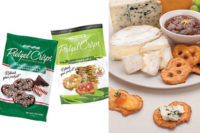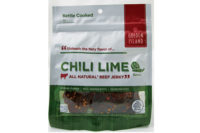
The news is nearly two months old by now, but that doesn’t make it any less astonishing: chocolate giant Mars Inc. purchased gum kingpin Wm. Wrigley Jr. Co., creating a global confectionery powerhouse, controlling an estimated 14% of the world’s candy and gum dollar volume (when the deal is finalized later this year).
There have been notable acquisitions over the past decade-Perfetti SpA buying Van Melle NV in 2001, Barry Callebaut AG taking over Stollwerk Group in 2002 and Brach’s Confections Holding Inc. in 2003, Cadbury Schweppes plc (now Cadbury plc) buying Adams in 2003, and Ülker Group adding Godiva Chocolatier to its already sizable stable last December. The Mars-Wrigley deal tops them all, not only because of its size, but because of what it says about the state of the global confectionery market.
When two of the most successful global candy companies link up for purely strategic reasons and, as Wrigley flatly stated, not due to any international market influences, it immediately ratchets up the pressure on those not necessarily as well-positioned to compete in a global marketplace, one that is simultaneously rife with opportunity and fraught with some of the most challenging business conditions in years.
Specifically, the deal augurs a new era of consolidation in the industry, as confectionery manufacturers look to take advantage of burgeoning global demand while dealing with a barrage of issues-from soaring raw material costs to heightened consumer nutritional concerns-that are making it difficult to meet that demand.
Per capita opportunity
The global confectionery market is arguably in the midst of the best growth cycle in its history. From 2002-2007, worldwide retail revenues grew by more than $40 billion, according to London-based research firm Euromonitor International-a far cry from 1997-2002 when sales actually declined by more than $1 billion.In 2007 sales grew 3.3%, topping the $140 billion mark for the first time. Gum led the sector, jumping 5.3%. Chocolate posted a respectable 3.8% increase. Sugar confectionery pulled up the rear, managing only a 1.6% gain. Combined, it was a solid performance driven by new product innovations and a growing confectionery appetite in developing nations.
The latter driver has been well documented over the past few years. Economic growth in China, India, Mexico, Russia, the oil producing nations of the Middle East and elsewhere is running two-to-four times U.S. and Western European growth. As incomes rise in developing nations, dietary habits shift toward more Westernized gastronomies. That means more dairy, more beef, more foods you can find at any U.S. mall foodcourt, and more traditional confectionery products, particularly chocolate and gum.
Last year, Eastern European and Latin American confectionery sales jumped nearly 16%, according to Euromonitor data. The Middle East/Africa registered a gain of 9.3% and Asia Pacific 5.4%. Together, the four regions accounted for more than 75% of 2007’s incremental growth, and they will continue to be the category’s driving force through the mid term.
For 2007-2012, Euromonitor projects a compound annual growth rate for Asia Pacific and Eastern Europe at 4.8% and 4.5%, respectively, followed by the Middle East/Africa (+3.5%) and Latin America (+3.3%)-all higher than the United States and Western Europe.
Results from some of the major confectionery players lend weight to such forecasts. Cadbury posted double-digit growth in Asian emerging markets in 2007. Sales in India rose 20%, marking the third straight year of greater-than-15% expansion. Russian revenues increased 20%, Mexico 12%. Brazil sales are up 70% over the past four years, and the nation is now Cadbury’s eighth largest global market. Emerging markets accounted for one-third of the company’s total confectionery sales and 60% of dollar growth in 2007.
Ferrero Group’s Brazilian subsidiary posted 26% growth in 2007 and projects a 35% increase in 2008. Within five years, the company says Brazil will be among the group’s top 10 global markets.
Wrigley saw sales in its Asia region rise 20%. Although its EMAI region includes all of Europe (and not just Eastern Europe), the company specifically pointed to gains in Poland and Russia as helping to drive a 26% increase. Sales in Latin America and the Pacific rose 18%.
Trends indicate vast potential across most developing markets. Wrigley President and Chief Executive Officer Bill Perez cited some potent statistics at the company’s 2008 annual stockholders meeting this past March. Nationally, gum consumption in Russia is 94 servings per person; in China, it’s 22 servings; in India, it’s only six servings. By comparison, U.S. annual per capita consumption is 180 servings.
“Clearly, there is significant upside,” Perez said.
Moving Russian consumers to just 125 servings, far less than the U.S. average, would create demand for 4.4 billion more sticks/pellets per year. Moving China to 30 servings per capita-simply eight more than they currently consume, a seemingly modest proposal-would create demand for 10.6 billion more pieces annually. And moving India to China’s current level of 22 would require 18.4 billion servings per year. Perez called the Indian opportunities alone “extraordinary,” an assessment with which Candy Industry is forced to agree.
And that’s only gum. Per capita consumption of chocolate in the Asia Pacific region pales in comparison to consumption in the United States (conservatively estimated at 12 pounds a year) and Western Europe (estimated at around 24 pounds). China’s per capita chocolate consumption is less than 1 pound. Simply moving the needle to 1.5 pounds per year in China alone creates demand for more than 660 million additional pounds of chocolate per year. Indonesia, South Korea and other Asian nations all feature similar per-capita gaps with Western consumption levels and will add fuel to the growth trend.
Over the last 18 months, manufacturers stepped up efforts to build capacity and distribution networks to meet the expected growth. Cadbury brought a new gum plant online in Poland; Hershey inked a distribution joint venture with Pandurata Alimentos to build its presence in Brazil, and Wrigley expanded the size and capacity of its Shanghai gum plant to support what it called its “booming” business in China, to name a few.
Barry Callebaut, which opened new facilities in China and Russia, says it is in the process of adding 10 more factories either through new construction or acquisitions.
“We are making significant investments into expanding our global footprint especially in high-growth emerging markets to secure our future growth,” Chief Executive Officer Patrick De Maeseniere noted in the company’s interim earnings conference call in April.
Healthy and wealthy
With such statistics, it’s easy to get carried away with the potential of the developing world. But Canada, the United States and Western Europe still account for 57% of global confectionery sales, according to Euromonitor. North American (Canada and the United States) revenues grew a very healthy 5.8% in 2007, aided by growth in premium chocolate, but Western European sales slipped 5%.One reason for confectionery’s poor showing in Western Europe was dietary concern. “Weight-conscious consumers are switching to low-calorie alternatives such as fruit snacks and ‘light’ snack bars [instead of chocolate],” says Francisco Redruello, a Euromonitor research analyst.
The key to sustained growth in both regions revolves around their success and failure last year: i.e., premium products and nutritional concerns. In developed countries in particular the watchword is “premium.”
“Trading up in mature markets” holds the biggest opportunity for confectionery makers these days, says Tobias Bachmuller, managing partner of Katjes Fassin GmbH & Co. KG.
It’s an opinion shared by other manufacturers, judging by recent high-profile new product launches-notably Hershey with its Starbucks line (rolled out nationwide in March in a range of coffee- and tea-tinted flavors, including Tazo Chai-infused chocolate squares, Caramel Macchiato and Madagascar Vanilla Bean truffles, and Milk Chocolate Covered Caffè Verona coffee beans) and Bliss chocolates (to compete head-to-head with Dove), Mars with M&M’s Premiums (Triple Chocolate, Mint Chocolate, Mocha, Chocolate Almond and Raspberry Almond) and Russell Stover Candies Inc. with its American Classics (Mississippi Mud Truffles, Southern Pecan Chocolate Torte and New York Cheesecake Ganache).
Also this year, Kraft Foods Inc. rolled out Toblerone Tiny and Cote d’Or stand-up bags to compete with upscale stand-up pouches from Alfred Ritter GmbH & Co. (4.72-oz. bags of Minis) and Russell Stover (4.95-oz. bags of Internationale varieties). All are gaining shelf-space in outlets where five years ago they would have been deemed out of place, such as c-stores and drug stores.
Organic, which falls under the premium umbrella, is seeing similar new product development, expansion and consumer uptake, with Cadbury’s Green & Black’s brand leading the way. Green & Black’s revenues were up 20% worldwide last year, backed by entry into new markets, including Australia, Ireland and South Africa.
The added benefit for premium products is that they are less likely to be affected by rising prices, an issue of growing prominence across all sectors of the food industry.
“When you talk about the premium segment, the consumer is willing to pay a bit more for quality. If you go to a mass market brand and have a small increase in price, then the consumer may switch to a private label or another mass market brand that is cheaper,” Redruello says. Or refrain from buying altogether. “Premium consumers are more resilient, more attached to taste or quality or whether or not the product is organic. The more premium you go, the less effect a price increase has.”
People also appear willing to pay more for products that provide some type of functional benefit, be it energy or beneficial nutrients to help protect against disease. “Healthier” confections are a trend that transcends market type, applying to developed and developing markets alike.
Says Euromonitor: Heart-healthy properties will boost chocolate growth, functional properties will derive gum sales, and health-oriented innovations will underpin the performance of lollipops and toffee in the near future.
In Eastern Europe, functional gum sales will grow 48% from 2007-2012, Asia Pacific almost 30%, Western Europe 20%, according to Euromonitor. Conversely, the group predicts a 40% decline in sugared gum in Western Europe and a 22% decline in North America, as consumers trade up from sugar to functional products.
Redruello believes that consumers will be willing to pay for such premium products.
“We see functional gum growth not only in Western Europe, where there is higher purchasing power and a greater emphasis on health and wellness, but in Eastern Europe, where we project 9% growth in functional gum from 2007-2012,” says Redruello. “Eastern Europe,” he stresses, “where price is very important.”
More and more consumers are turning to lines claiming to benefit oral and cardiovascular health or featuring relaxing/soothing properties, according to Euromonitor research.
To meet consumer desires and grow sales, manufacturers are turning more to such products as well. Leading the way are teeth-whitening and enamel-hardening gums and a slew of dark chocolates touting antioxidant content.
Any attendee to this year’s All Candy Expo in Chicago, May 20-22, saw far more. Green tea products (featuring the antioxidant ECCG) abounded, from Gumlink US Corp.’s green tea formula gum to Anhui Fukang Pharmaceutical Co.’s green tea mints and pastilles to Sencha Naturals green tea mints and snack bars.
Attendees also couldn’t escape an aisle without encountering at least one high-octane energy enhancing candy, from Jelly Belly Candy Co.’s now-veteran Sport Beans to Tootsie Roll Industries Inc.’s new Maxxed Energy pops to a whole list of espresso-riddled chocolates and caffeine-laden gums and mints.
For some, even the idea of being thought of as a candy company these days is undesirable. Confectionery powerhouse Nestlé SA hardly mentioned chocolate and didn’t mention sugar candies at all in its year-end conference call. The multi-national food giant previously announced its intention to remake the business as a health and wellness company.
In its 2007 annual report, despite $10-billion-plus in confectionery sales, Nestlé delves into specifics only to single-out Bodacitos (which it describes as “light indulgence” snacks made with corn, wheat and cereal pieces with fiber, coated with chocolate or yogurt) and Trencito Milki, a product launched in several Latin American countries that uses a special “sintering” technology to enrobe a powdered milk center with milk or white chocolate.
Candy companies need to recognize that “consumers are taking control of their health through the food choices they make,” said Barry Callebaut’s De Maeseniere in April. “The increasing demand for food that increases the feeling of well-being has led us to develop a range of health enhancing chocolates.”
Since fall 2007, Callebaut rolled out probiotic chocolate, a “tooth friendly” chocolate, fiber enriched chocolate and a “rebalanced” chocolate with an “improved nutritional profile.” On the premium side, it launched single-origin and plantation-origin products as well.
Healthy is a must. But just as targeting developing nations at the expense of heavy-buying U.S. and Western European consumers would be shortsighted, focusing solely on nutritional confections would be a mistake. As Katjes’ Bachmuller says, “There is strong growth potential [in functional and “healthy” candies], but still a small basis.”
Two sides of the same coin
Overall, growth in the global confectionery sector has been strong, and manufacturers have some clear geographic and product-specific expansion opportunities. If that were the whole story, candy company stocks would be skyrocketing.But along with such growth has come problems. Rising global food demand is driving up costs. Poor weather (severe drought and floods) and growing emphasis on biofuel production is cutting into agricultural supplies. Throw in speculators looking to make a buck on commodity markets and you get skyrocketing costs.
Simultaneously, apart from ingredient inflation, energy, distribution and packaging costs are spiking, straining margins and sending candy company profits in many cases tumbling. At the precise time when a growing number of consumers around the world have the money to spend on confections they previously couldn’t afford, had avoided or simply did not know about, rising prices are threatening to put them out of reach.
Milk powder prices reached record highs last summer, and while down since then, they are still running 30-50% more than just two years ago. Cocoa prices soared 50% between September 2007 and February 2008 before moderating in March.
When Candy Industry asked a cross-section of confectionery manufacturers what would be the biggest challenge to the business this year, they stated nearly unanimously “input costs.”
No end is in sight
Barry Callebaut’s De Maeseniere noted in April that the company expected raw material prices “to remain challenging for the remainder of our fiscal year.” The U.N. Food and Agriculture Organization and other global monitoring agencies point to even more dire conditions, predicting higher food prices will remain in place for some time.The rising costs forced a wave of wholesale and retail price hikes at the end of 2007 and the beginning of 2008. The ultimate consumer reaction remains to be seen.
Hershey likes to point out that the price of a standard bar is still below $1. Kraft reported double-digit growth in chocolate for the first quarter of 2008, behind strong performances from its Milka, Toblerone and Cote d’Or brands. Cadbury still projects a sales gain of 4-6% this year.
Cadbury is covering all its bases with strategies such as the one it implemented in Brazil. The company expanded distribution into the north and east, reduced indirect costs, and rolled out a range of products targeting both the premium and affordable ends of the market. In India, it introduced Bubaloo, a product that uses affordable gum-based technology from Latin America, and gained a 5% share of the Indian bubblegum market in six months.
Other companies may not have the scale to match Cadbury’s efforts. If Wrigley and Mars, who were doing quite well on an international basis, decide it’s time to join forces, where does that leave everyone else who is working on a local or regional scale?
Some say even Cadbury is too small, speculating it will acquire Hershey or itself be acquired by Kraft. One thing is certain, with conditions the way they are and the global sweet tooth getting sweeter, confectionery companies need scale, innovation and the utmost in efficiency now more than ever.







